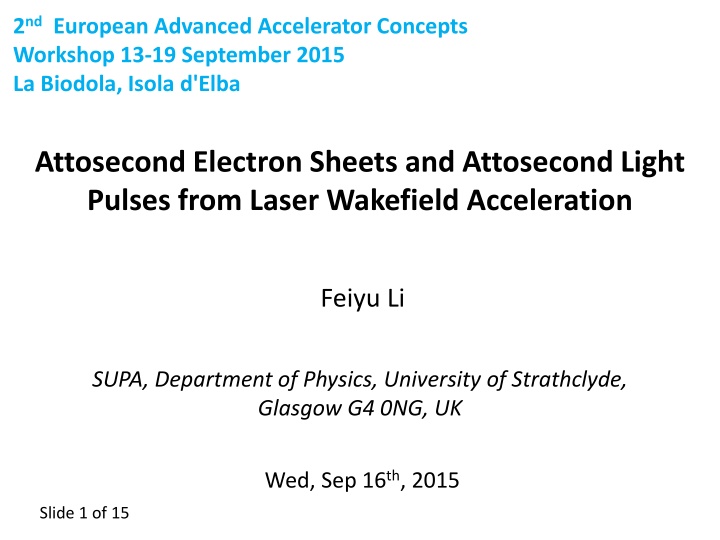
Cutting-edge Insights on Accelerator Concepts and High-energy Physics
Explore the forefront of accelerator concepts and high-energy physics at the 2nd European Advanced Accelerator Concepts Workshop. Delve into topics like attosecond electron sheets, laser wakefield acceleration, and plasma wave motion. Discover the significance and applications of coherent Thomson backscattering and high-energy attosecond light pulses. Gain insights into breaking plasma waves as flying mirrors, experimental campaigns, and limitations with innovative solutions.
Download Presentation

Please find below an Image/Link to download the presentation.
The content on the website is provided AS IS for your information and personal use only. It may not be sold, licensed, or shared on other websites without obtaining consent from the author. If you encounter any issues during the download, it is possible that the publisher has removed the file from their server.
You are allowed to download the files provided on this website for personal or commercial use, subject to the condition that they are used lawfully. All files are the property of their respective owners.
The content on the website is provided AS IS for your information and personal use only. It may not be sold, licensed, or shared on other websites without obtaining consent from the author.
E N D
Presentation Transcript
2ndEuropean Advanced Accelerator Concepts Workshop 13-19 September 2015 La Biodola, Isola d'Elba Attosecond Electron Sheets and Attosecond Light Pulses from Laser Wakefield Acceleration Feiyu Li SUPA, Department of Physics, University of Strathclyde, Glasgow G4 0NG, UK Wed, Sep 16th, 2015 Slide 1 of 15
Acknowledgement Z. M. Sheng: Strathclyde Univ. & SJTU M. Chen: SJTU (Shanghai Jiao Tong Univ.), J. Meyer-ter-Vehn: MPQ, H.-C. Wu: Zhejiang Univ., W. B. Mori: UCLA, W. Lu: Tsinghua Univ. Y. Liu, J.-L. Liu, M. Zeng et al. SJTU, M. Weikum: Strathclyde. Slide 2 of 15
Outline The flying mirror model based on plasma wave motion Attosecond (10-18s) sheets in wakefield accelertion Coherent Thomson backscattering (KeV photon energy) High-energy (~10mJ), single attosecond (~100as) pulses Significance/applications Summary Slide 4 of 15
Breaking plasma waves as flying mirrors Plasma waves excited in underdense plasmas have been responsible for a wide range of phenomena (compact particle acceleration, novel radiation generation, etc), mostly in debt to acceleration Large plasma density waves created by ultrashort intense laser pulse have the ability to compress plasma electrons into dense ultrashort bunches surfing at relativistic speeds, which may serve as flying mirrors. Wavebreaking Quasi-1D Towards Schwinger limit: ne~ 1017cm-3 ph~ 100 Driver diameter ~ 800 m Probe laser ~ 1017W/cm2 Focused X-rays ~ 1.3 1029W/cm2 Slide 5 of 15 Bulanov, et al. KSF 1991, PRL 2003
Experimental campaigns Major features: - Monitoring collision at fs timescale - Driver: ~ 1018W/cm2 - ne~ a few 1019cm-3 - ph~ 4-8 - Doppler shifts: a few tens - UV or XUV lights - Probably Bubble regime Kando, et al. PRL 2007, 2009 Slide 6 of 15
Limitations & Solutions? = = 2 2 p 2 0 2 p 4 4 4 4 cn n 0 n 2 0 2 4 laser P a W 1) X-ray backscattering requires very low density Low density requires stronger driver and broader diameter, thus extremely high power Using large diameter can be vulnerable to plasma density non-uniformity Using low density is even harder to form converging density wave spikes 0 0 2) 3) 4) Slide 7 of 15
Controlled injection of attosecond electron sheets The ramping-up density provides the control and makes sure that the density wave crests are stably compressed without premature injection Superluminal region Sub-luminal region Superluminal Sub-luminal Slide 8 of 15 Li, et al. PRL 2013
Parameter space & 3D sheets propagation Onset of injection Slide 9 of 15
Kiloelectrovolt-level coherent Thomson scattering Due to non-injected spike 2D nonlinear backscatter 1D linear backscatter Li, et al. APL 2014 Slide 10 of 15
High-energy single attosecond pulses Plasma: ne~ 7 1019cm-3 Electron sheet Laser: ~ 7 1019W/cm2, w0~15 m, peak power ~300TW, energy ~5J Radiation Attosecond pulse: ~10mJ, saturated at ~ 4 1019W/cm2, > 7 1020W/cm2 converging Slide 11 of 15 Li, et al. PRE 2014
Novel features Coherent synchrotron radiation Radiation field ( ) 1 tan + E// E 0 Single attosecond (~100as) pulse, no needs of filtering High energy (mJ-level), high conversion efficiency (>10-3) Quasi-1D regime; scale up to larger driver spots and higher laser powers Slide 12 of 15
Looking at the bigger picture Relativistic generation [compared with gas harmonics] Gas targets (making use of the nature of plasma wave motions to compress into attoseconds) [compared with nanofoil-based schemes which require harsh laser conditions] Slide 13 of 15 Mourou, Tajima, Science, 2011
Summary We have explored new possibilities of LWFA, namely the highly nonlinear quasi-1D regime along with controlled injection of dense electron sheets, which allow for bright attosecond bursts of coherent X-ray/XUV pulses; The new path relies on relativistic generation using gas targets, allows for both high repetition rates and high intensity, whilst requiring affordable laser conditions as well as fitting well into higher powers which are coming up soon. Slide 14 of 15
Thank you for your attention & Questions/Comments Slide 15 of 15
